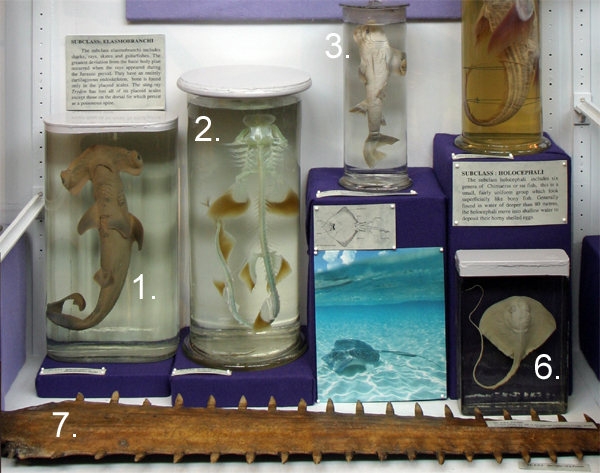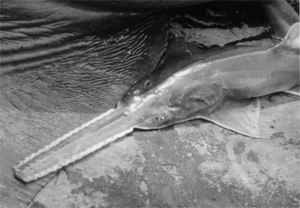
SUBCLASS ELASMOBRANCHI: SHARKS, SKATES & RAYS
Elasmobranchs – sharks, skates and rays – are a very diverse group: some have the classic body shape associated with sharks and rays; others are highly modified. Our specimens include an embryonic and a young Port Jackson shark, a small hammerhead shark, egg cases and embryos of types of cat shark looking like miniature adults, a small spiny dogfish, a very young saw shark, embryonic skates,and a small stingray. Embryonic sharks, skates and their egg cases are displayed separately here.
 |  |  |
1. Sphryna zygaena (Family Carcharhinidae). A young hammer-headed shark, Adults may reach 2 feet (60 cm). Hammerhead sharks have been seen to hold down sting-rays, their preferred food, with their heads while taking chunks out of them with their sub-terminal mouths. These sharks feed mainly at night and occur in large shoals during the day.
2. Scyliorhinus caniculus (Family Scyliorhinidae). Cartilaginous skeleton of the lesser spotted dogfish or small spotted cat shark is comprised of a skull or cranium, jaws, gill arches, vertebral column and fins. The fin rays are soft and unsegmented (ceratotrichia). There are no ribs or operculum as occur in bony fish. Adult lesser spotted dogfish reach 1 - 1.5 metres. Dogfish live on the bottom in cold deep waters through the world, feeding with their short stout teeth on molluscs, crustaceans and bottom-dwelling fish. The different common English names of this shark are rather confusing and contradictory.
3. Heterodontus portusjacksoni (synonym H. philippe) (Family Heterodontidae). A small Port Jackson shark, a common bottom-dwelling horn shark of continental shelves in the Western Pacific Ocean. Adults are only 1 metre long. They are called horn sharks because of the horn-like ridges above the eye. Their pointed front teeth and crushing plates are used for feeding on benthic invertebrates, primarily echinoderms. Sharks do not usually care for their young but female horn sharks wedge their eggs into crevices to protect them form predators while they develop. The Port Jackson shark appeared in the Jurassic period, at the time of the dinosaurs, and may be viewed as a survivor of primitive sharks. Reproductive strategies of cartilaginous fish.
4. A very young saw shark (Family Pristiophoridae). This specimen is 20 cm long, adults grow to about 1.8 metres. Saw sharks are quite rare. The long barbels on the saw help the sharks to find their prey – molluscs and crustaceans - on the sea-floor. Their teeth are broad for crushing their prey. The saw is an extended snout edged with a row of unequal sized, weakly attached teeth. It is probably only used for defence.
5. Squalus acanthias (Family Squalidae). Probably the most abundant shark, spiny-dogfish are bottom-orientated predators primarily of bony fish of cold waters. Rarely reaching a metre, they may live for 70 years. This specimen in 46 cm long. The females give birth to 1 to 20 live young; their gestation period is 2 years.
6. A small sting ray (Family Dasayatidae). Lacking scales on the body, sting rays have one or more modified scales with venom glands at their base, which form a sting on the dorsal side of the tail. Sting rays feed on crustaceans and invertebrates using crushing pavement–like teeth. The tail or sting is probably only a defensive weapon against predators. Some sting rays are very small (30 cm) across but the Indo-Pacific Smooth sting ray may reach 2 m across.

7. Saw of Pristis sp. (Family Pristidae). The sawfish is a highly modified ray – its snout extends into a saw - a long flat blade armed with equal sized, firmly fixed teeth. Adults may reach 7 metres including the saw. The saw is used for digging, defence, and feeding. The fish slashes the saw through schools of fish and then devours the resulting decimated and incapacitated fish. Sawfish also feed on molluscs and crustaceans crushed by short flattened teeth on the saw. This saw is 90 cm long.






